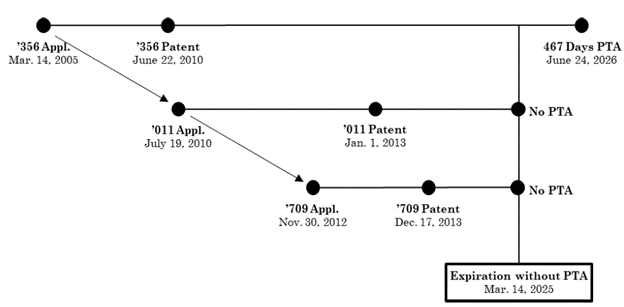Selective Readings of Cellect: Federal Circuit Carves out First Exception to Burgeoning Double Patenting Challenges
Introduction
Last year, the Federal Circuit surprised many observers of patent law in In re Cellect LLC, 81 F.4th 1216, 1228–29 (Fed. Cir. 2023) when—for the first time—it affirmed a U.S. Patent & Trademark Office decision cancelling an earlier filed patent for “obviousness-type” double patenting (“ODP”) over a series of later filed patents in the same family. On August 13, 2024, the Federal Circuit offered some relief for patentees in its decision reversing a decision from the District of Delaware in Allergan v. MSN Labs, where it distinguished between a first filed patent in a family and (as was in issue in Cellect) a patent that was not the first filed in its family.
Patent Family and Background
A variety of generic drug companies including MSN Labs had all submitted Abbreviated New Drug Applications (ANDAs) to market eluxadoline (Viberzi®) tablets in the United States. Allergan sued the ANDA applicants for infringement of U.S. Patent Nos. 7,741,356 (“'356”), 11,007,179, 11,090,291, 11,160,792, and 11,311,516. The ’356 patent was the founding member of a family that includes six other granted patents. The ANDA applicants defended on the grounds of invalidity of ’356 under the doctrine of ODP under Cellect, because ’356 had 467 days of patent term adjustment (“PTA”), while various of the continuation applications that descended from ’356 had no PTA. The relationship between the filing, issuance, and expiration dates of each of the ’356 patent, U.S. Patent No. 8,344,011 (“’011”) and U.S. Patents No. 8,609,709 (“’709”) is depicted in the following figure:

Meanwhile, the other asserted patents were alleged to lack written description. The U.S. District Court for the District of Delaware agreed with the ANDA applicants that the asserted patents were invalid. On appeal, the Federal Circuit reversed.
The Federal Circuit Reverses the District Court’s ODP Holding
The ANDA applicants challenged the asserted claims of ’356 on the grounds that these claims ran 467 days past the expiration of ’011 and ’709. Based on the decision in Cellect—which had been interpreted as meaning that only the expiration dates of the patents-at-issue mattered for the inquiry—the challengers argued and the Delaware court found that ’356 should require a terminal disclaimer over ’011 and ’709. The Delaware court concluded that the failure to give such a terminal disclaimer made ’356 invalid for ODP.
The Federal Circuit disagreed and distinguished the facts of this case from those of Cellect. In particular, the court noted that the first-filed patent of the family of patents in Cellect was not involved in the litigation. Rather, Cellect involved challenges of child and grandchild patents that were granted PTA based on another grandchild patent that had not been awarded any PTA. In Allergan, however, the challenge was to the first-filed patent’s PTA. This turns out to be an important distinction.
The Federal Circuit explained that the existence of the PTA process evidenced Congress’ intent to extend certain patents’ terms beyond the 20-year-from-filing default (slip op. at 13). The court also noted that the first patent in a family is the one most likely to generate PTA because it contains issues that are unresolved at the start of prosecution, but which the Examiner and Applicant will resolve together over the course of prosecution, and which will therefore be resolved already by the start of prosecution in any child or grandchild (etc.) application (slip op. at 19 & 20). The court reasoned, therefore, that it would frustrate Congress’ intent when it established the PTA system to apply the logic of Cellect to the “first-filed, first-issued” patent in a family (slip op. at 20).
The court made much of the fact that ’356 was the “first-filed, first-issued” patent in a family, including specifically stating that this patent “sets the maximum period of exclusivity.” This should prompt one to wonder if the same outcome would obtain if the challenged patent had been the first-filed, but second-issued, or second-filed, but first-issued. Given how finely the court parsed the distinctions in fact patterns between this case and Cellect, a patentee would do well (where possible) to keep within the facts of this case by waiting until the first-filed application is allowed and on its way to grant before pursuing a continuation. Nevertheless, the court’s repeated reiteration that—following the Uruguay Round Agreements Act (URAA) of 1994—the filing date rather than grant date triggers the expiration clock, suggests that a first-filed case should be able to take advantage of this precedent even if that first-filed patent issues after another application in the same family.
Although this cabining of Cellect is a favorable outcome for patent holders, many patent applicants may choose to continue as they had been doing after Cellect. It remains the case that a divisional is not subject to ODP attack—a fact which may affect what sorts of subject matter a patent applicant will choose to pursue when filing child applications. Similarly, many patentees put their maximum efforts into obtaining the broadest claims in the first-filed patent application in a family, and will continue to do so. Devising and executing a well-planned strategy for any given family of applications requires consideration of many facts and risks, and patent applicants will do well to seek the advice of counsel to arrive at an optimum strategy for each of their patent families.
Disclaimer: The information contained in this posting does not, and is not intended to, constitute legal advice or express any opinion to be relied upon legally, for investment purposes or otherwise. If you would like to obtain legal advice relating to the subject matter addressed in this posting, please consult with us or your attorney. The information in this post is also based upon publicly available information, presents opinions, and does not represent in any way whatsoever the opinions or official positions of the entities or individuals referenced herein.


